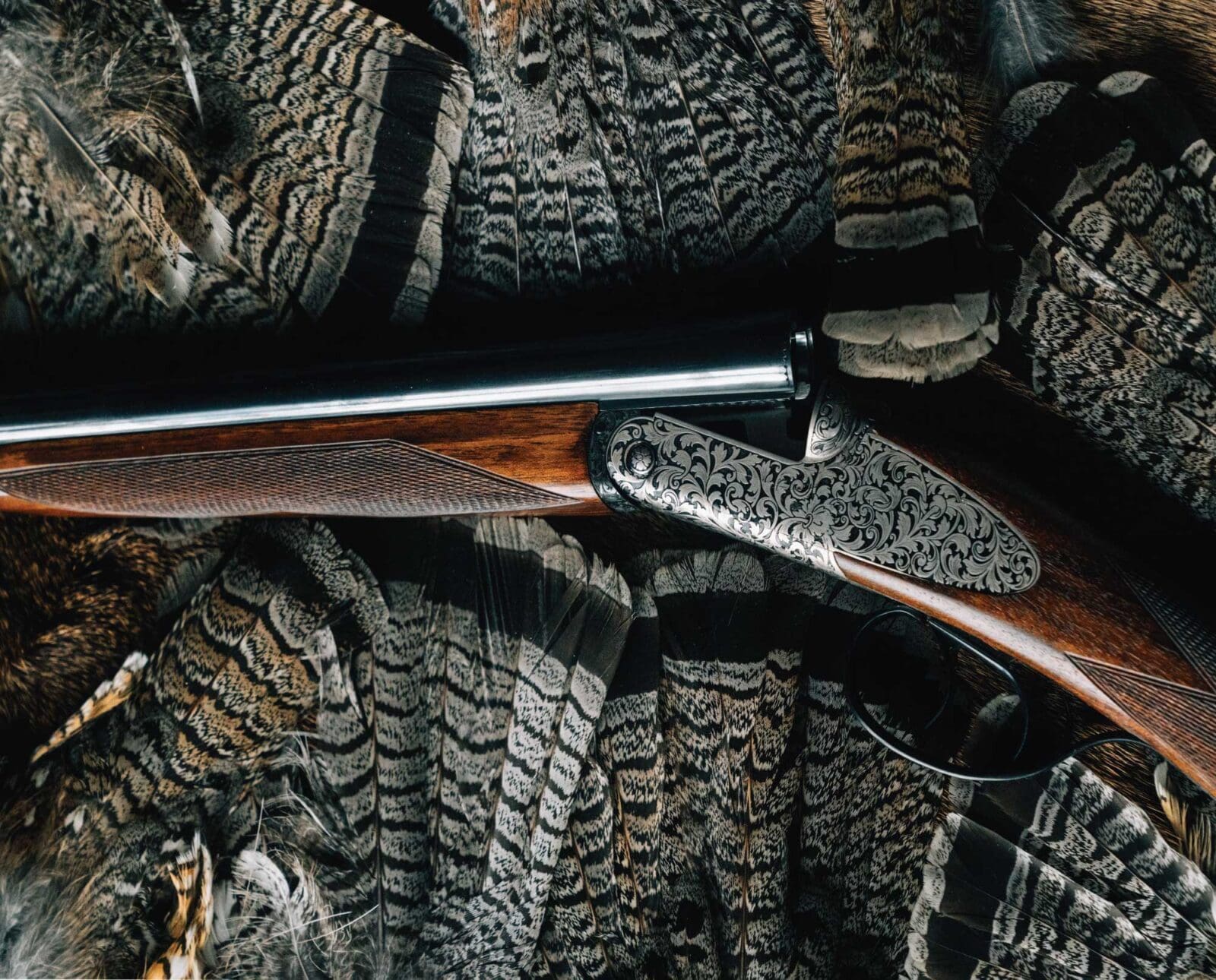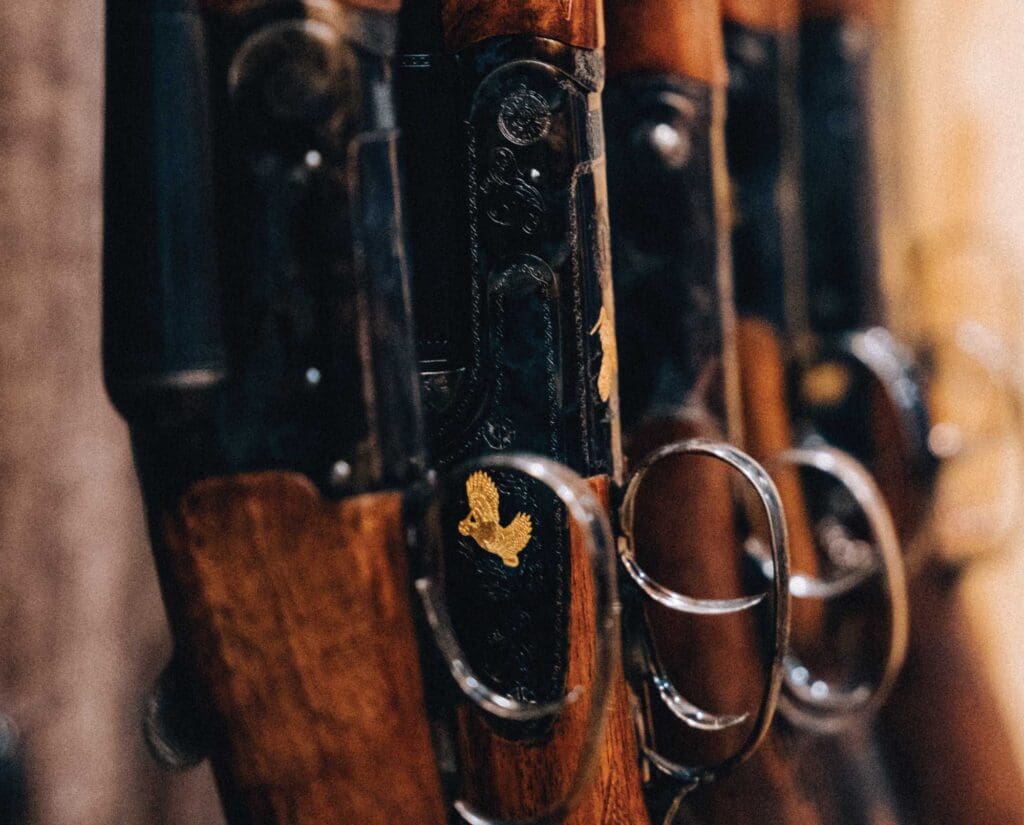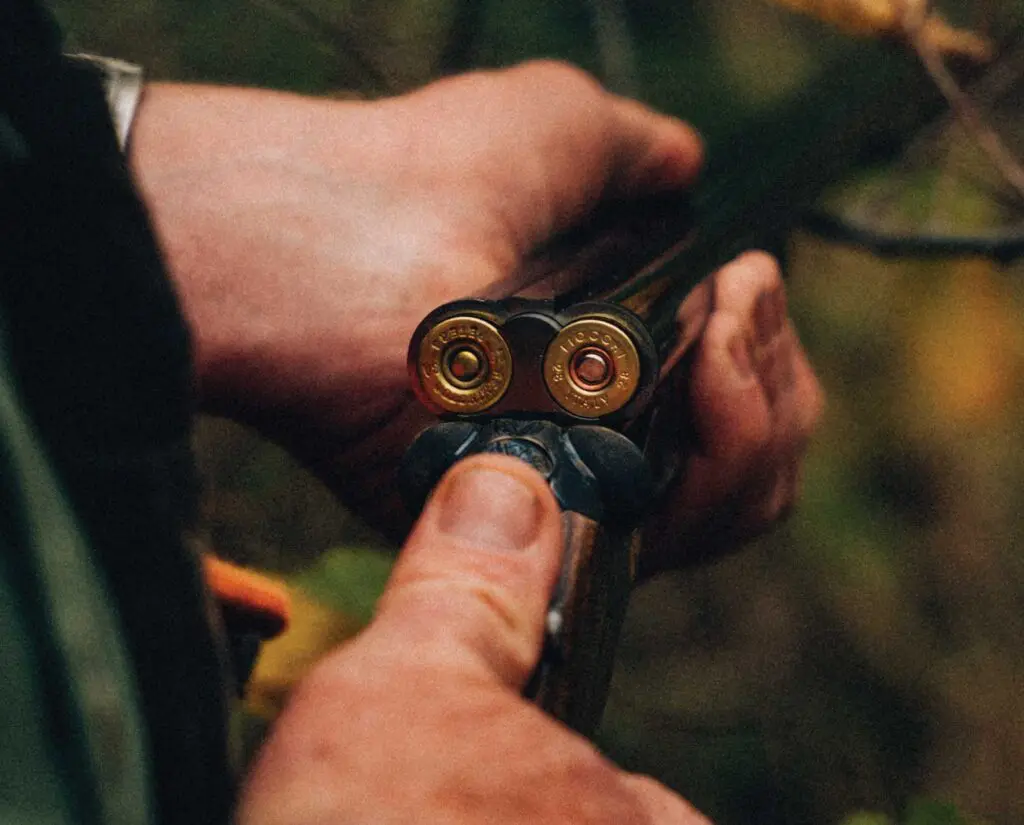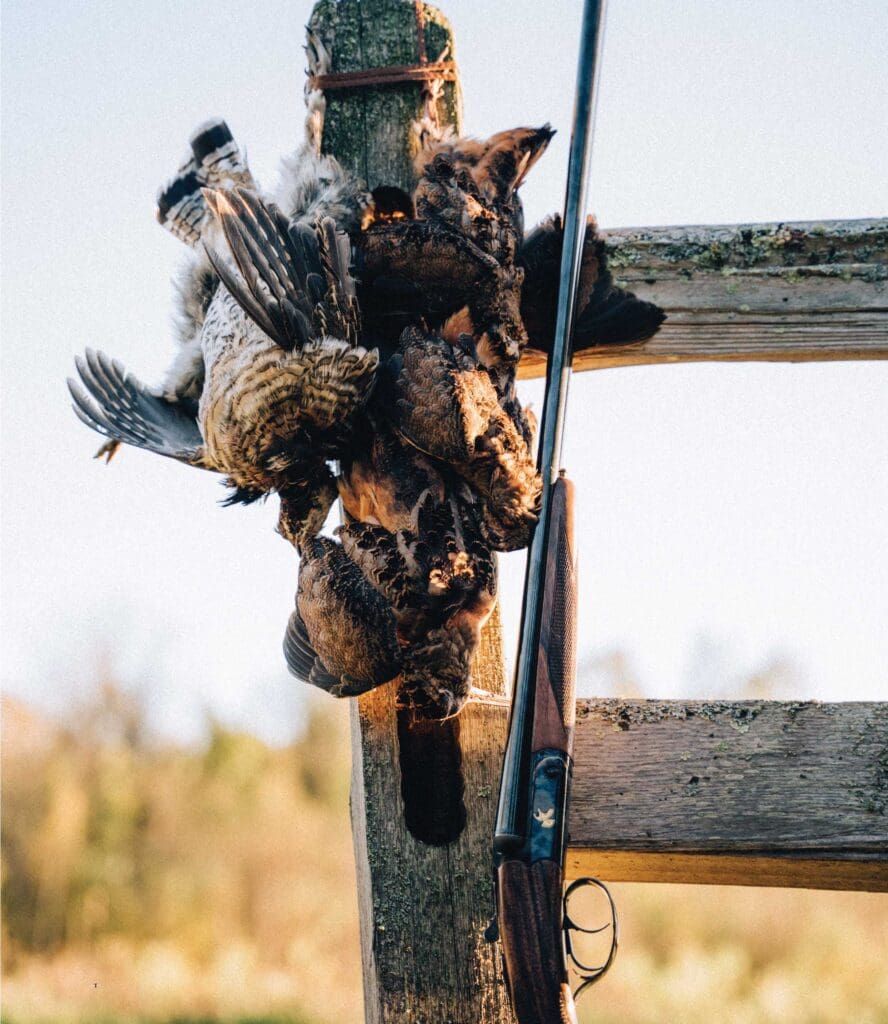Home » Firearms and Shooting » Shotguns » Defining a Grouse Gun – A Shotgun of Specialist Function
Defining a Grouse Gun – A Shotgun of Specialist Function

A.J. DeRosa, founder of Project Upland, is a New England…
Defining the attributes of the perfect ruffed grouse gun over generations of grouse hunters and authors from weight to barrel length
The text came through immediately: “Are those my initials?” I had just sent my dad a photo of my newest grouse gun: an Upland Gun Company, RFM-built Venus boxlock 28-gauge weighing five pounds, one ounce with 28” barrels choked skeet and skeet. Being a Junior makes my custom guns a regular lighthearted topic between us. Candidly, I owned a lot of shotguns before this one, and I’ve made many errors in judgment along the way. I am already sure I would change a couple of things on this one. However, this was my error, not Upland Gun Company’s.
Listen to more articles on Apple | Google | Spotify | Audible
One of the few things my father and I bond over is guns. He’s why I started collecting guns as soon as I was old enough. I went through phases of obsession ranging from action types to unique calibers and even historical pieces. I would sell them and buy others or find one to save up for but never actually buy them. I am what someone could call “gun poor;” I own guns beyond my practical means at the expense of other things. It’s habitual, and I have no regrets. However, along the way, I learned a lot of lessons about poorly made guns, guns that didn’t fit me, and, ultimately, guns that did.
I grew up on pumps and semi-automatics. My first over/under didn’t come until 20 years ago, and my first side-by-side shotgun arrived eight or nine years after that. However, I accelerated my journey into double guns by taking many trips overseas. I toured gun factories on said trips and spent time with owners, experts, and engineers. They patiently answered my never-ending questions. Since then, some have come stateside to see the sights and even hunt grouse.
There are many strong opinions about what makes a good grouse shotgun. While I’m in line with most of them, others were more outlandish. One time, over lunch, a gun company owner told me that the weight of a grouse gun did not matter. In my typical uncensored fashion, I blurted out, “Then you haven’t truly grouse hunted.” That relationship has been rocky ever since, but I said what I said, and I meant what I said, and I would not be alone in that opinion. Honesty has to count for something.

What makes an ideal grouse gun, or what Gene Hill would call “a gun of specialist function?” Does action type matter? What about gauge? How does the environment play into it? How has the modernization of gun-making changed grouse guns? How different is a grouse gun from a clays gun? How different is a gun built for ruffed grouse hunting versus shotguns used for other wild game? While I don’t have all the answers, I do have theories. Like any evolving tradition, they’re built on the backs of those who came before me.
“An ideal grouse gun may be defined broadly as the one that a certain hunter will find most pleasant to carry to the spot where a grouse is to be shot at, and there prove most efficient when the shot is made.” Foster’s words may be the most elegant I have ever encountered when defining a grouse gun. They capture the subtleties of practical factors like weight, gauge, and gun fit while never explicitly mentioning them. Less poetically, he says, “I need to carry this gun through a mess of grouse cover and shoot when I get there.”
Gene Hill would echo that sentiment over 50 years later in Shotgunner’s Notebook:
It’s a special gun, built for snap shooting in the heavy alder and birch covers and for ease toting up and down New England hillsides . . . I think we can agree that among its special functions is that it’s easy to carry, meaning it has decent balance and doesn’t weigh more than seven pounds and preferably a bit less.
The Weight of a Grouse Gun
One can only wonder why some modern gunmakers push upland shotguns built for field applications into the eight-pound category. As Gene Hill said, let’s try and keep them under seven pounds. I argue that weight is the most relevant conversation around the ideal grouse gun.
To be frank, grouse hunters do a lot of gun carrying, often one-handed, navigating thick cover, and do a lot more lugging than shooting. The weight of the gun is a centerpiece of this whole conversation. If you account for the standard good practices, like buying a gun that fits, is mechanically sound, shoots a standard load that patterns well, and you take the time to get good with that chosen shotgun, then the weight is about the only conversation left.
One’s physical build, whether towering six-plus-feet tall or a more average 5’10”, can push the weight of a gun across that five- to seven-pound spectrum. Simple things that contribute to weight can be gauge size, barrel length, quality of manufacture, and the action type. The whole conversation of a grouse gun cascades from the idea of weight.
The Double Gun Rule
Indeed, shoot whatever action type you like when grouse hunting. However, those expecting more mention of a pump or semiautomatic will be sorely disappointed. If we are talking about grouse guns in the classical sense (and we are), then we are talking about double guns.
I did not make the rules; the culture did. The double gun rule began at the dawn of modern grouse hunting. George Bird Evans called it the “gentlemen’s agreement.” It has to do with your number of shots and giving a ruffed grouse a fair chance on the wing. Being humbled is a cornerstone of the enjoyment of grouse hunting. Practice good conservation ethics and consider how your bag limits affect your local population.

How Gauge Plays a Role in Grouse Shotguns
Ruffed grouse’s difficulty is in their cunning behavior, not in their ability to take a shot. The point is it does not take much to kill a ruffed grouse. William Harnden Foster wrote, “In referring to some carefully-kept records . . . we find that the average distance at which grouse were killed throughout the seasons was in the neighborhood of twenty-three yards. These records were compiled by shooters of average reactions who use guns weighing a little under six pounds.” He advocated for pattern testing the first barrel at 25 yards and the second at 35 yards noting:
Since a missed grouse going away will travel at least ten yards before the shooter can recover his aim for the second shot and because the second bird of the rare, true double will also be ten yards farther away by the time it comes in for attention, there seems to be no more reasonable solution to the second barrel boring problem than to give it the pellet-to-the-square-inch average at 35 yards instead of 25 as was the accepted range of the first.
The 12-, 16-, 20-, and 28-gauge are acceptable gauges for ethically killing a bird, considering shots occur almost entirely under 35 yards. When choosing your gauge, you’ll find it’s very similar to the weight spectrum. The smaller you are, the more you will benefit from a lighter gauge. That applies to performance with recoil, how your hands fit on the shotgun, and the overall weight of the grouse gun.
While I often scratch my head at grouse guns that can take 3″ or greater loads, I guess it is not a bad option for those that occasionally seek waterfowl and do not have a dedicated shotgun for such an adventure.
Barrel Length on a Grouse Gun
One of my favorite grouse guns is a wonderful 20-gauge Bernadelli with 24″ barrels and custom Briley chokes that weighs five pounds and 11 ounces. However, I have never said, “If I only had four inches less on my barrels, I would have hit that grouse.” If I had been more observant or technical, I might have learned sooner that a longer barrel makes for a better swing and, therefore, more successful shots. I know some old-school folks will send me hate mail on this, but the need for short barrels is no more than a myth in grouse hunting. Quite the opposite is true. When brush gets in the way, as it often does, it won’t matter what your barrel length is.
“When we talk of the length of the barrels we have in mind the symmetry and balance of the gun,” wrote Foster in his one-sentence elegance. The need for longer barrels often becomes more evident with the lighter gauge you shoot. Twenty-eight-inch barrels on a 28-gauge feel like a must to me. I am not sure I would ever want any shotgun with less than 28” barrels unless there were no other options. This leads to the next point of the ideal grouse gun. It is not built to win gold medals; it is meant to be hauled great distances while still being effective.

Always Practice with Your Grouse Gun
“Because you lose the natural momentum that exists in a heavy (eight pounds or so) 12-gauge, you have to learn a new set of shooting habits,” wrote Gene Hill when talking about upland shotguns. Hill refined the difference between shooting on the range and upland hunting. While he pointed out differences in how these specialty guns are designed, he emphasized getting good with the hunting gun you choose. It’s that simple. A “specialist shotgun” requires a specific set of shooting skills, and if we are to hold to Foster’s simple definition, then we must be “efficient” with the grouse gun we choose.
My practical behavior in this realm began in the past five years. I made a point of sticking with the same shotgun from August until the end of the season. I keep my shotgun beside my desk, allowing me to religiously practice my gun mount, developing my muscle memory. Since that commitment, I have certainly experienced a significant change in my shooting abilities.
Final Thoughts on the Ideal Grouse Gun
One of the greatest failures of modern grouse gun manufacturing is the need for more ability to order custom dimensions. Shooting a shotgun built to your measurements may be the greatest advantage to shooting straight. Some of us are luckier than others; they can pick up that gun rack gun, and it’ll be a close fit. They are built to fit the average person, after all. We outliers can genuinely benefit from getting measured for a custom gun fit.
My newest grouse gun, the Upland Gun Company Venus 28-gauge, meets my individual needs almost perfectly. One of the gun’s perfections is that it’s built to my dimensions. Their base model, the Zeus, starts at $2,499.00. That price tag includes custom-building it to your dimensions. As every gun collector knows, we always think of an excuse to buy that next “ideal” shotgun.
While collecting and shooting guns is a great way to learn foundational lessons in identifying good shotguns, grouse hunting is the only way to know a gun intimately enough to say it’s an ideal grouse gun. “Few sportsmen are fortunate enough to make, early in their careers as grouse hunters, their ultimate choice of a gun,” wrote Foster. “Some never settle on one with which they feel wholly satisfied, but keep on changing and experimenting, swinging like a pendulum from one extreme to the other. Fortunate and heroic indeed is the grouse hunter who can say, ‘I can think of no change that I would care to make in the gun that I have used all these years that might improve my shooting.’”
A.J. DeRosa, founder of Project Upland, is a New England native with over 35 years of hunting experience across three continents. His passion for upland birds and side-by-side shotguns has taken him around the world, uncovering the stories of people and places connected to the uplands. First published in 2004, he wrote The Urban Deer Complex in 2014 and soon discovered a love for filmmaking, which led to the award-winning Project Upland film series. A.J.'s dedication to wildlife drives his advocacy for conservation policy and habitat funding at both federal and state levels. He serves as Vice Chair of the New Hampshire Fish & Game Commission, giving back to his community. You can often find A.J. and his Wirehaired Pointing Griffon, Grim, hunting in the mountains of New England—or wherever the birds lead them.




Excellent article, and completely spot–I have a Parker Reproduction 28 with 26 inch barrels–lovely gun but I agree 28inch barrels would be perfect. Very nice to hear that Mr. DeRosa purchased an RFM shotgun. I too just ordered a Venus model only in 20 gauge. Sadly I had to sell a lovely Bernardelli 16 gauge to cover the upgrade. But it was well worth it. Keep up the good work.
I also just ordered myself a Venus in 20 gauge, really looking forward to this gun but it seems to be quite long delivery time for them. Also sold of a gun to make place in the gun safe/licence restrictions here in Sweden, a Browning B525 The Crown. I am more of side-by-side guy anyway.
Nice article and also loved the RFM armi movie of yours, actually found out of Project Upland due to my research online of the RFM guns.
AJ, Enjoyed this like all your other articles. Glad you can make a living with this lifestyle you love. I’m a Griff guy as well so feel a bit of kindred spirit. You mention in paragraph one of a couple of changes you would make in your Venus now that you have lived with it a bit. Curious of your proposed changes?
Hey Ed! My biggest change would have been to not get side plates. After that I am still up in the air between the fixed chokes I chose. In this case case skeet I and skeet II. I should think I may have went cylinder and I/C next time.
This might sound funny, but ever since I started using double’s to chase grouse… it never really crossed my mind to have both barrel chocked the same… probably because having access to two different patterns is what got me to step away from semi/pump in the first place.
Anyway, great article… grouse season is just around the corner, be safe!
I agree, weight is the most important aspect of a gun your gonna carry for miles. I suggest getting closer to 6 pounds if possible. I shoot a CZ upland ultralight. Everyone that picks up my gun is amazed by how light and quick to the shoulder it is. Also it’s not a super expensive gun so setting it broken on the forest floor is a good option while dog handling. I prefer 20 gauge mainly because I can always find the ammo I need. One thing this article is lacking is the discussion of chokes used for grouse. In the day of swappable chokes it shouldn’t be a big issue, however not all guns come with all the chokes one might need to say hunt heavy cover. Just my 2 cents.
There are some proven parameters that define the kind of shotgun needed for ruffed grouse hunting in North America. The shotgun, preferably a side-by-side, should have between-the-hands balance and have the proper length-of-pull and cast dimensions that make the mounting of the gun second nature during the violent split-second of a grouse flush. If you have to think too much about the gun when mounting, success won’t come easy. As to barrel length, longer barrels point more precisely than shorter ones on a well-balanced, properly fit double gun. My 28-gauge AyA boxlock has 29-inch barrels and my Featherweight frame 16-gauge OO Grade L. C. Smith has 28-inch barrels. Both guns have straight grips, double triggers, splinter fore-ends and are choked close to Skeet 1 and Skeet 2. The AyA weighs five pounds 10 ounces and the Elsie weights an even six pounds. Both balance at the hinge pin and have been custom-stocked to fit my left eye and six-foot-four-inch frame. I use light loads traveling around 1150 fps. with 5/8ths ounce of #8s in the 28 and 15/16 ounce of #7 1/2s in the 16. I use the AyA in October when the woodcock are in and the Elsie in November/December when the grouse are spookier and fully feathered. There is no finer upland game bird than the ruffed grouse, in the field or in the oven. And there is no finer shotgun to hunt them with than a classic side-by-side double.
Not a Ruffed Grouse hunter, none in Texas, but I do hunt woodcock in SE Texas and Louisiana. I normally shoot a 26 inch barreled, 55 y. o. 20 ga Ithaca-SKB O/U, IC &. Mod., 7/8’s oz of 7.5 Boss bismuth behind my Pudelpointer. It has 3” chambers that come in handy when approaching creek bends that may hide Woodies(I switch out the light loads for 3” Boss #6 shot). That’s why a 3” chambered ‘speciality’ shotgun is very nice for the area and way I hunt.
I have a tough time not jumping wood ducks myself. Certainly a great application.
You’re just not sneaky enough! But I do put the dog on a leash as I approach the known Woodie hangouts.
The best grouse gun is the one that you shoot the best.
Absolutely!
i can absolutely tell you about the best gun for grouse, that is, the gun you shoot the best I knew an older man who would only shoot an old well-worn Browning Sweet Sixteen and he was lethal. when I asked him why he shot the humpback he didn’t go into some long diatribe about the cast of the stock or balance of the gun, he simply said; “it shoots where I look”. after all isn’t that what we all want? Just like birddogs, I would much rather have a sickle tailed drop, who has a burning desire to hunt with a radar nose and a desire to please than a registered dog with a poker straight tail who culls the briars and creeps on point. Now, was this article really about shooting grouse or the pride of ownership of beautiful shotguns? If owning a fine bespoke side by side 28 ga. makes you happy go for it but just remember it is the man behind the gun that counts